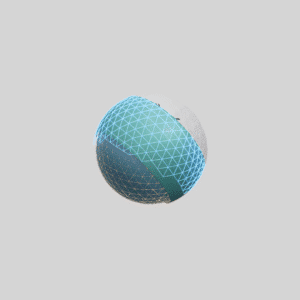
Dimples. Some people have them. Some people don’t. For golf balls, however, they’re a must. Just as a donut without a hole is a Danish, a golf ball without dimples is, well, just a ball. Here are a few truths about golf ball dimples to liven up the banter at your next 19th hole visit and shed a little light on this often-misunderstood attribute.
1. They Were an Accident
Necessity may be the mother of invention, but unintentional enlightenment is the father of innovation. Let us explain. The first golf balls developed in Scotland in the 1600s were known as “Featheries.” As the name implies, they were made of a leather pouch filled with bird feathers (typically goose down). The stitched leather pouch and feathers were soaked in water to make them pliable and then the pouch was stuffed through a small slit.
Allowed to dry, the leather shrank, and the feathers expanded which made the ball tight and hard. Believe it or not, these balls had to meet a standard size (established in 1800) of 1.5” and 1.54 ounces, which is smaller and lighter than today’s current standard (1.68” and 1.62 ounces). However, they could travel 200 yards when hit. Unfortunately, they didn’t last very long due to getting hit repeatedly and absorbing moisture.
The next iteration of golf balls, “Gutties,” were made of gutta percha – dried gum resin from the Sapodilla tree commonly found in Malaysia. The first Gutties, like their predecessors, were smooth. But golfers noticed they’d fly further with a few nicks in them which made the ball surface “rougher”. Ball-makers across Scotland began to forge grooves in gutties – golf’s first version of dimples.
In the early 1900s, American Coburn Haskell invented the first wound core ball. He and Bertram Work of the Goodrich rubber company in Ohio patented the Haskell ball – a liquid or solid core golf ball wrapped tightly with rubber threads and a gutta percha cover with a bramble pattern. A dozen years later, the bramble pattern was replaced by the superior, modern dimple. Even then players were complaining about the extra distance from the Haskell ball and that it was ruining the game. Courses had to be lengthened by as much as 100 yards!

2. They are (Mostly) Unregulated
The golf ball is one of the most scrutinized and argued about pieces of golf equipment we have. As you might expect, the United States Golf Association (USGA) and Royal and Ancient (R & A) have spent decades writing and re-rewriting the rules regulating their design and construction. You would think dimples would be a significant focus, given that golf balls with dimples flies nearly twice as far as those without.
But that’s just not the case. The USGA has no restrictions on how many dimples a golf ball can have, their size, shape or pattern. Crazy, right? As a result, dimples are the one area in which golf ball manufacturers can throw caution to the wind and have some fun. Over the years there have been balls with hexagonal dimples, raised centers in the dimples, deep dimples and shallow dimples. However, golf balls must have a symmetrical arrangement and be in a specific range of radius and depth for overall performance.
The dimple spectrum for regulation golf balls is 300 to 500, with most mainstream and TOUR-caliber balls in the 310-399 range. OnCore’s new 2022 ELIXR has 350 dimples, while the first generation ELIXR has 318. The two-piece, low-compression AVANT 55 has 392 dimples and the high-compression four-piece VERO X1 has 318, like the first ELIXR.

3. They Greatly Impact Ball Flight
According to OnCore Golf Senior Technical Advisor, John Calabria, the purpose of dimples on a golf ball is to increase distance by controlling/optimizing lift and decreasing drag. Deep dimples result in a lower ball flight, while shallow dimples produce a higher ball flight. For example, you might have hit a golf ball on a driving range that knuckled and didn’t travel very far. This was likely due to the dimples being worn out from the cleaning process. Next time you are at the range, look closely at the balls you are hitting. If you find one with small dimples, try hitting that ball along with a newer range ball. You will be surprised at the difference.
Calabria says the optimal surface coverage with dimples is 80%, delivering the highest performance. Speaking of surface, the amount of paint used on a golf ball also affects its trajectory and is controlled very tightly. If paint is applied too thickly the dimples are shallow and (as pointed out above) the higher the ball flight. If enough paint isn’t applied then the dimple is too deep and the ball will fly lower than designed. Surlyn balls like AVANT 55 typically get two coats of paint while white cast urethane balls like ELIXR and VERO X1 receive three but the dimple pattern is designed specifically for these amounts.

4. They Shouldn’t Drive Golf Ball Selection
When it comes to selecting the right ball for your game, don’t fixate on dimples. Swing speed is the most critical variable, according to Calabria. High-compression balls like the VERO X1 rely on club head speeds of 100 mph or greater for full compression, whereas super soft, low-compression balls like AVANT 55 respond to swing speeds under 75 mph. Calabria also recommends testing different balls around the greens and on approach shots to see what works best for you.
As for those dimples, well, just keep smiling and you’re sure to hit more fairways and greens.
Ready to find the perfect OnCore ball for your game? Take the next step with our Ball Fitting Assessment and get fit today.
Father’s Day Special
Stock up and Save!






